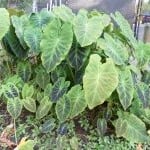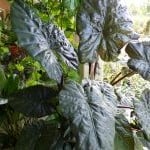
Alocasia vs Colocasia
Elephant ears have striking tropical foliage which can enhance any landscape. Used in ground or in pots, foliage is large textured, arrow shaped leaves and come in shades of green to dark purple/ black. How do you know the difference between Alocasia and Colocasia? Some say the leaves of one point upward and the other points down but this is not always true. They are cousins however and belong to the same family, Araceae.
Alocasia macrorrhiza is an herbaceous perennial bulb which grows in fertile, well-drained soil in full sunlight to partial shade. Plants can grow 4 to 6 feet wide and tall and is propagated by division of bulbs. Foliage of Elephant ears consists of simple leaves with wavy margins that are 2 feet or more. The blades are held erect and parallel to the stems. These plants have a coarse texture with clumping form and can be used in containers. They grow will in moderately moist soils. Foliage in killed by frost. Old foliage should be cut back. Mulch plant bulbs heavily in areas that may freeze. New bulbs should be planted in spring, Fertilize with a general purpose fertilizer in spring once the new foliage appears and again in summer for larger leaves. Water often especially if the plant is in full sun.
Colocasia esculenta or common elephant ear also known as Taro, is an herbaceous/wetland perennial that is naturalized in the Deep South. Colocasia esculenta has the same requirements as Alocasia as it likes moist soil with organic matter and does well in full sunlight to partial shade. Some can grow in water. This plant can become a problem as it is a rapid grower and spreads easily and should not be planted in waterways. It is propagated by underground corms. Has upright leaf stems with coarse texture and dramatic foliage that makes a heavy mass.
Some varieties: Alocasia ‘Zulu Mask’, A. ‘Frydek’, Colocasia ‘Black Coral’, C. ‘Antiquorium’.
submitted by Karen Blackburn




